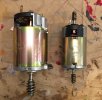Hi PhilMight I suggest the ZIMO MX696N non-sound decoder and LOKPL96KS screw terminal lok interface board, about €116 at Grootspoor.com. I think these will work together but not I'm sure. Perhaps one of the experienced ZIMO users out there (Greg?) will confirm. Or even the MX696KS sound decoder package for around €155 also at Grootspoor.com. You may even get the 17% VAT removed being in Cyprus.
Seems like you are hardly the neophyte you claim as to understanding CVs, etc. given your N scale experience and what you've already accomplished puttering around in G. A ZIMO decoder will give you a good chance to experiment with the ZIMO programming software. I don't believe you need to purchase the ZIMO programming module to use the software as you have the MX10. Again, perhaps an experienced ZIMO user can confirm.
Speaking from personal experience I found the ESU LokProgrammer very daunting at first. It took quite an effort to understand even basic operation. Principally because the english translation of the manual was not so good. It turned out to be pretty straight forward once I actually tried using the ESU programming software on a real decoder. It just required going back and forth to the manual. I'm hardly an expert now but I was able to actually load a custom sound on an ESU decoder after using the LokProgrammer a bit. You really can't break the decoder unless it is incorrectly wired in the first place. The decoder reset is your "get out of jail free" card.
Again thanks for your advice, I have had several inputs from this and other sources and I think you and the others are correct regarding a sound board as a start. We haven't started the purchase process yet so I will think it over during the next few days, we meet again on Monday morning we can make a decision then. I would like to go the screw terminal route but a soldering iron isn't a problem if pushed.
At the very least you gave me the push I needed to try the conversion.
Robin


